“Focusing Change to Win is a must read and reference for business people regardless of their company’s size. Whether you run a family business or public corporation, this book has thought provoking tools and questionnaires you can use immediately. Nick Anderson and his co-Author Kelly Nwosu have done a masterful job in distilling over 6000 business leaders’ comments into such a practical set of tools. If you want your next change to be successful, this is essential reading.”
Bill Connors, President, Boise Metro Chamber of Commerce
Failed change means lost opportunity, competitive vulnerability, poor revenues and valued employee turnover. Perhaps however, the most damaging impact is increased cynicism and fear which develop hostile and toxic cultures where change resistance is the norm.
Section 1: Why is this important now?
- Change management’s track record isn’t getting any better and, isn’t likely to, if we don’t do different things.
- Change failure rates continue above 60%
- Surveyed executives still say people are the main reason for failed change
- Technology is delivering faster, opportunity-rich yet still often underutilized solutions
- Many leaders say their current business models are misaligned with emergent realities, unforeseen challenges, and changing priorities.
- Many also confess they don’t know how to go about fixing what’s no longer delivering sustainable competitive advantage.
Today change management is even more challenging. Unfortunately, any consensus on the causes and solutions of failed change remain elusive. Yet, some organizations do manage successful change. So we asked:
What are the meaningful differences between those that thrive on change and those that just survive?
After analyzing over 6000 business leader comments from 80 countries, there are clearly those leaders who understand this condition and those who do not. They realize that working relationships are increasingly stressed in the drive for ever faster responses to competitive threats and opportunities. Unfortunately, too many are still trying to do things differently not do different things.
This summary of Focusing Change to Win gives a taste of this change manual for leaders. It distills the collective wisdom of over 1000 business leaders and consultants each with years of change-management experience. It outlines how the questionnaires and action points can be used to increase the chances of change success
Section 2: The Why and What of Change
We take an in-depth look at how our contributors improve their chances of thriving by communicating in ways that build trust and engage people. For these contributors, communication must constantly focus on:
- The Why of Change &
- What is Expected &
- What the Change is not about.
This is the Change Expectations Framework. It engages deeper understanding and helps everyone manage stress more effectively.
Note: You may think everyone does these three steps. You are probably wrong at least 70% of the time, according to studies over the last ten years. Here’s why it is even more important today: Most contributors (89%) say that their organizations change at least every 12 months. These changes are driven by 3-4 simultaneous factors. To succeed, such changes should have three things in common – what you expect people to:
- Stop doing, (so that they can start doing new things)
- Start doing, and
- Continue doing
Yet, this survey’s findings show that contributors rarely mention all three in the same contribution. Why is this important? Because it creates increased stress and potentially change resistance.
Section 3: Why Do People Resist Change?
Here’s the reality, Leaders need employee support and trust if their change is going to stand any chance of success. Our contributors underscore this. If people are cynical about a change, pessimism will set in, and failure is assured. Our contributors show that there are no simple remedies, no sound bites or grizzly 7 step plans. Yet, at its core there are fundamental values that, if believed in, will offer a sound basis for planning and executing successful change. Change failures have left their mark on our contributors over the last eight years. Through their eyes, resistance is a brownfield site where change is synonymous with downsizing, doing more for less, and treating people poorly.
Accelerated change demands more of everyone. Such change has major consequences for employees. Accelerated change failure creates cultural toxicity. Crucially, leaders need to separate the symptoms of change resistance from the stress that causes it. If they don’t, they are just like bad sales people trying to overcome objections and not realizing 60% of those objections are of the salesperson’s own creation. These contributors, they are saying that change resistance is natural, but you don’t need to make it more difficult if you do some things profoundly well. The chart below gives a sense of the avoidable.
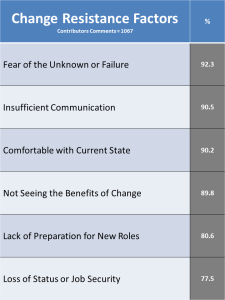
Once you recognize that Change Resistance causes stress then you can be more effective in reducing it. Our contributors say that, if leaders create clear and consistent frameworks, you help most people make informed decisions about committing to a change or not. Here’s what our contributors are saying:
- Align Expectations between leaders and people
- Set Clear Direction: Leaders clarify their change’s What, Why, How and WIIFMs (What’s In It For Me) for different groups and people.
- Develop Accountabilities: by developing the rewards and consequences that assure expectations of both leaders and their people are met.
These are sound practices for reducing and managing people’s stress, but only if leaders realize the importance of Walking Their Own Talk.
Section 4: Why Bother Measuring Change? 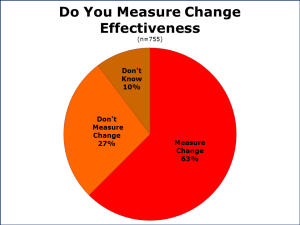
Another striking disconnect is the low numbers of those who see benefits of measuring change’s impact on marketing and customers. This is curious, as our contributors’ most common reason for losing customers is not price but poor quality (92.2%), poor follow-up by sales people (76.5%) and making the wrong assumptions about customers (64.5%). After detailed analysis, it would seem that the relationship between change and competitive advantage is not as clearly visualized as one might think.
In addition, the use of employee metrics including personal performance, resistance to change, improvement to company culture and understanding our purpose, are low compared to satisfaction surveys. Most concerning is the lack of focus on individual behavioral change and tracking pay-related rewards. This is further evidence of little focus on accountability and establishing a requiring environment
Even when metrics are agreed upon, the next challenge is creating greater transparency so that they are used to create and sustain change momentum.
What Questions do Change Metrics Need to Answer?
Overall, there needs to be more focus on developing effective change metrics. The challenge is: How well do your change metrics accelerate learning, problem solving and decision making?
In Section 4, we distilled contributor questions on what they need change metrics to answer into a questionnaire. We ask readers to go through and rate their current metrics under three sections:
- Navigating during a Change
- Reviewing a Change
- Planning the Next Change
Our contributors suggest establishing a change scorecard with their leadership team and key stakeholders. For example by:
- Agreeing on those questions which the team needs to answer
- Deciding what current metrics could be put to good use
- Assessing during the change process how well they cover the risks of losing customers through poor product or service quality and poor sales follow-up.
And finally……Asking how well your scorecard helps you sell this and subsequent changes?
Section 5: How Can Implementing Change Gain Competitive Advantage?
Even after 30 years, the connections between change management and gaining competitive advantage are not well articulated. The disconnects between commitments to change and actual competitive behavior are a major factor in change failure. Getting beyond imitators relies on understanding and measuring behaviour that distinguishes competitive behavior from other activities.
As one contributor said
Learning keeps us ahead of the competition by getting us closer to selected customers to gather competitive intelligence
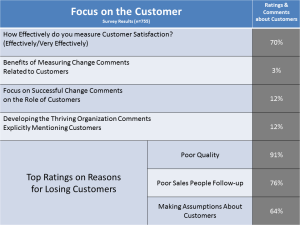 get a new customer than it does to keep an existing one. Acquiring new customers is costly, and in many cases, the money earned on the first sale doesn’t even cover the acquisition costs.
get a new customer than it does to keep an existing one. Acquiring new customers is costly, and in many cases, the money earned on the first sale doesn’t even cover the acquisition costs. For example in the table to the right, only 70% of contributors say they measure customer satisfaction effectively. Worst still are the low percentages for the benefits of measuring change related to customers (3%) and their feedback when it comes to change success (12%)
These findings have uncomfortable resonance with the lack of customer focus we see in other parts of this report. Change drives these leaders, while customers and competitive advantage are apparent afterthoughts.
We conclude that there are practical ways to avoid these pitfalls. Overall, contributors comment that managing change for competitive success is a continuous, systemic, repetitive and uncertain process. They recommend five areas to improve competitive advantage through change.
Section 6: Is Your Organization Thriving or Just Surviving?
This in-depth analysis shows the wide range of factors that go into developing the Thriving Organization. Our intent in being comprehensive is deliberate. We want leaders to select which questions are most appropriate to them.
Our reasoning is that there are no simple solutions or steps to follow. What we urge is open debate in leadership teams to reach a commitment to those few things which can make a difference between being ahead and just playing catch up.
Thriving or Surviving Questionnaire
There are 69 questions to select from divided into seven categories to help as you develop your plan for building a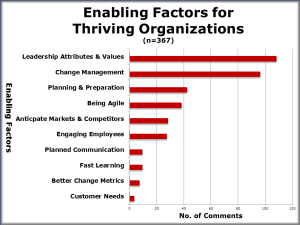 more vibrant and competitive organization.
more vibrant and competitive organization.
- Leadership in Thriving Organizations
- Change Management in Thriving Organizations
- Planning to Thrive
- Agility to Thrive
- Thriving People
- Communicating to Thrive
- Learning to Thrive
Section 7: How Effectively Are You Communicating Change?
The following is based on 684 contributors who chose to add comments on communicating change. Unsurprisingly, contributors see their people at the heart of any successful change process. They see gaining stakeholder commitment as a force multiplier of powerful change ambassadors. Essential to creating that commitment are leaders taking their people into their confidence with honesty and courage.
Surprisingly, however, our analysis also sheds light on some blind spots. Overall, contributors focus more on technique than systemic or strategic issues when communicating change. For example:
- They (Leaders) lack the ability to motivate or hold people accountable….they do a poor job at this…..lots of saying nothing….People are told, not asked.
Change Communication Blind Spots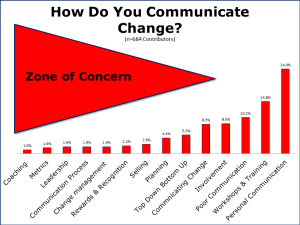
Real change requires authentic communication and dialogue across all organizational levels. Although, employee’s resistance and disagreement are unavoidable, contributors show how it can be managed through multiplexed and constant communication. They stress that this only happens when change communication is centered on establishing and retaining trusting relationships. If employees feel fairness, they will trust more and trust is the glue of success.
So, what role does communication play in reducing change mistrust and cynicism among employees? Frequently, it’s people’s sense of fairness. The communication timing, involvement and sequence impact their sense of justice.
Where’s the Requiring Environment?
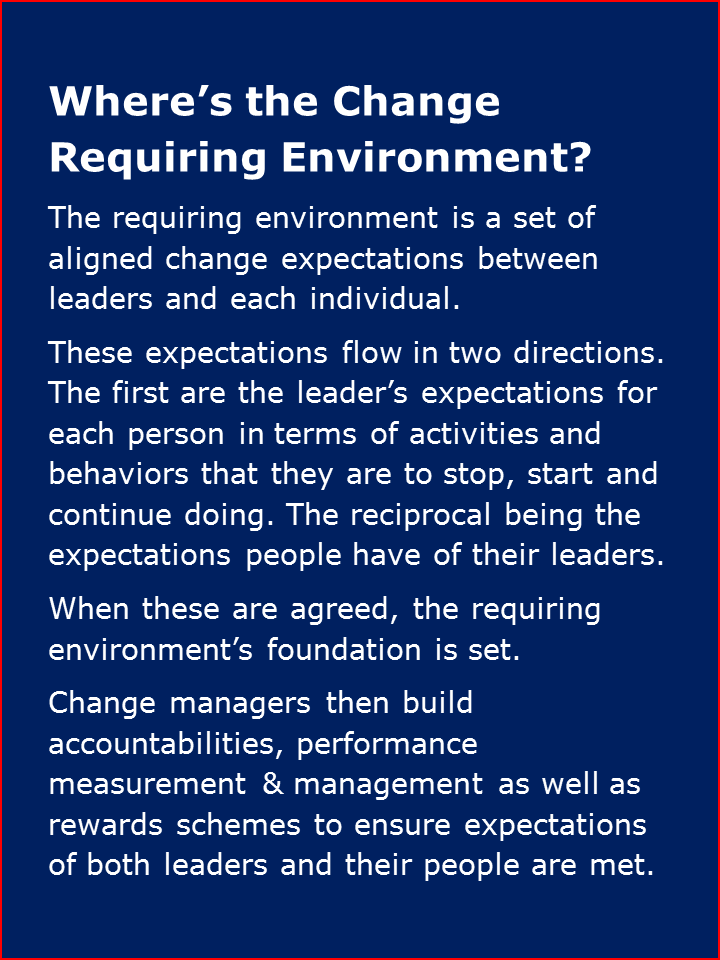
There seems little focus on improving alignment and change success. Issues like change management, communication, and change measurement were under 6% of contributors’ comments on communicating change.
Looking in more detail, a third of contributors said that they didn’t know of any change related communication or that their leaders don’t communicate enough.
For most contributors, real change is the outcome of authentic communication. They show how change can be managed through constant communication. Contributors often commented that trust in management was the only variable that significantly impacted change resistance.
However, comments on authentic communication and building trust seem to collide with those related to top down led change. Critical contributors point out that top down rests too often on leaders clinging to the belief that power, privilege and success lie in their core group. Whatever blend of top down and bottom up it is clear – one should be be intentional and as one contributor said:
- Being solid in the values you hold as a leader that needs clearly articulating and solidifying with your change management team before you start planning.
Our contributors are clear. Lay the groundwork for successful change before trying to carry out the next change. This starts with putting the change management team together before a specific change is planned. Then develop a shared governing set of values and design the change measurement framework.
Implementing Effective Change Communication Processes – A Questionnaire
This 38 question instrument was developed from 755 contributor comments on implementing an effective communication change process. It is designed to engage those involved in change management and leadership in selecting relevant questions and then reaching a consensus on improvement areas.
- Analyzing Change Impacts
- Set-up Change Program with Metrics
- On-going Communication & Training
Section 8: How Can You Lead to Thrive?
Clearly from this survey, leadership skills that focus change to win are at a premium. Today, change is the norm. It is neither random nor regular but hovers somewhere in between. How these interrelationships arise and how they challenge organizations is not well understood (IBM & KMPG Surveys endorse this)
Why should leaders focus on their organization’s essence?
An organization’s essence is the amalgam of mission, vision, values, intent and ethics. These components should be the focus of aligning and realigning people rather than delivering the corporate directives after a strategic planning retreat. Sustaining an organization’s essence is a dynamic that requires everyone’s engagement to define and redefine under changing situations.
It’s only by leaders “inter-reacting” that they can develop people’s shared clarity about the organization’s essence – “what we stand for!” From shared clarity comes confidence, from confidence comes cohesion and from cohesion comes the freedom to decide and act. That’s how organizations will stay on track today. Many people making many decisions true to their organization’s essence.
It’s also to be expected that some employees (including some executives) will not “buy into” an organization’s Essence once it is clearly defined. Leaders should then be prepared for those employees and managers to transition out of the organization. This will benefit them and organizational cohesion
What are the dangers of using technology to increase control?
Technology increases the illusion of greater control which can feed a leader’s “Control Addiction”. More measurement equals more control. But measuring what is easy to measure can have the very opposite effect. The problem is that most of what is easy to measure has already occurred. What is difficult is dealing with the factors that are difficult to measure and with forecasting what is likely to happen down the road. We can’t spend more time looking through the “rear view mirror” when we have a winding road ahead of us. Technology’s cheapness and speed feeds this addiction with the past and “looking in the rear view mirror” by access to ever more data and information at the cost of acquiring knowledge and wisdom.
This condition is worsened by technologists clinging to largely sequential design and deployment processes which are not fully user or client inclusive, e.g. “Waterfall Process”. Contrast this with agile processes which are fully supported by our contributors. See the link to comparing the Waterfall Process with Agile Methodologies.
Why do we have difficulty developing leaders that can thrive in today’s conditions?
Today’s conditions are not good proving grounds for the leaders we need. More of doing more with less, multi-tasking and the growing doubt that we may be doing the wrong things means that decision-making, and expectations are now more compressed. Consequently, entrenched expediency leads us into solving one problem so quickly that we find we have now created five more problems. We are so busy trying to solve problems there’s no time for “Where the hell are we going?” These conditions are not good for selecting or developing leaders who can work well under fluid and complex conditions.
How do we develop leaders that can thrive?
The tension between what Leader want to achieve and their current culture prevents traditional leadership training from making a significant impact. For example, many leaders’s previous training has left them feeling that they they could do a better job doing it themselves. Of course, too often this has not happened together with little sign that they have addressed their own or their junior leaders’ performance issues. The consequence is that leading up to a change they lack confidence and skills to handle the natural uncertainty that change creates. Consequently, they default to avoidance and expediency and as a result staff resistance rises morale suffers.
The conclusion is that Leaders need to develop a better framework to assess their competence to lead people and implement the next and subsequent changes more effectively.
In this section we outline how leaders can be developed to increase their chances of achieving both measurable short- and longer term results than traditional leadership training. It is based on approaches:
• Aligning People – Getting people on the Same Page
• Action Learning – Solving Difficult Problems while developing leaders’ skills
A Final Thought
Our position is that it’s only by energizing people and harnessing technologies better than anyone else that organizations can survive and thrive. Genuinely aligned, empowered and collaborative people will outperform the competition every time. A leader’s role is to create successful change that fulfills people and avoids human casualties. Leaders need to create working relationships that are rewarding not just superficially productive.
Summary
- Organizations must change with the times to remain successful and maintain competitive advantage.
- However, change failure rates currently are above 60%.
- To find out why, we analyzed 6000 business leader comments from 80 countries related to their experience with change management.
- Failure is caused primarily by people-related factors. Organizational change can be traumatic and resisted by those involved, and when it is, change fails.
- Leaders need aligned employees that support and trust change to stand any chance of success.
- Once Leaders recognize that change resistance causes stress (and vice-versa) and identify their specific stressors, they can be more effective in reducing it.
- Focusing Change to Win is a change manual for leaders which distills the collective wisdom of over ten thousand years of change-management experience. It outlines how questionnaires and action point checklists can be used to increase the chances of change success as leaders review, navigate and plan change
- Above all, this book is useful and practical! It provides guidance as you move to reap the benefits of gaining competitive advantage of implementing successful change in your organization.
For Help in Getting Your People on the Same Page ask Nick Anderson, The Crispian Advantage
E-mail I Web I Linkedin I Call 1+ (616) 745-8667
____________________________________
© Copyright All Rights Reserved, The Crispian Advantage and Walk the Talk – A Blog for Agile Minds, [2010-2012]. Unauthorized use and/or duplication of this material without express and written permission from this blog’s author and/or owner is strictly prohibited. Excerpts and links may be used, provided that full and clear credit is given to Nick Anderson, The Crispian Advantage and Walk the Talk – A Blog for Agile Minds with appropriate and specific direction to the original content.

